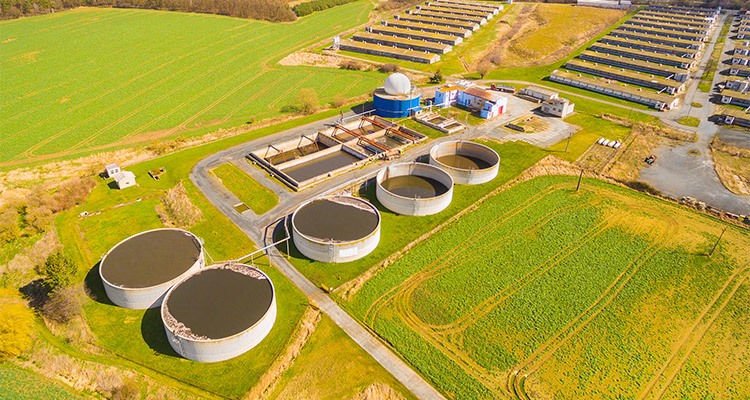Anaerobic digestion is a dynamic process in which bacteria break down organic waste matter in the absence of oxygen. This decomposition process creates a by-product that’s comprised primarily of methane, known as biogas. Without a method to capture this gas, it releases into the atmosphere as a greenhouse gas. Geomembrane covers for anaerobic digesters can address this, as well as other concerns. Anaerobic digestion is a practical means of dealing with waste products from agricultural, industrial, commercial and domestic environments. Animal waste lagoons, as well as sludge and wastewater facilities, utilize this process to provide a mass reduction of the input material. The anaerobic process occurs naturally, but there are methods for speeding up the process and making it more efficient. Some choose to create digesters as a lined earthen lagoon. With the benefits of ease of installation and cost effectiveness, digester lagoons are often typically employed in warmer climates. In cooler climates, however, a more engineered approach is required to help maintain temperature control, gas collection and mixing efficiency.
Reusable byproducts of anaerobic digestion – biogas and digestate
The digesters collect wastewater, sewage and other types of waste and break them down into biogas and digestate, a nutrient-rich biomatter. The anaerobic system uses less land as compared to aerobic digester systems, which use oxygen in the process. With the anaerobic process, organic materials are also broken down to a level that is more readily available for use in other applications. Even though biogas comes from an organic source with a short carbon life, when released, it contributes to atmospheric greenhouse gas levels. Combusting or collecting the gas eliminates this issue. When collected, biogas can be used to produce electricity and heat. Some of the gas is also used to maintain the operation of the digesters, and some of it is sold back into the local electric and heat supply. Using the biogas for energy production also reduces the payback period for any capital outlay involved, with energy profits occurring soon afterward. The digestate is the other byproduct created from the anaerobic digestion process. It’s a nutrient-rich mix of solids and liquid that is safe and effective as a fertilizer, for direct use on crops.Using geomembrane covers for anaerobic digesters
The use of geomembrane covers for anaerobic digesters provides a more cost-effective solution than steel or concrete containment systems - typically as little as one-eighth of the price. As a result, the use of geomembrane covers is becoming the most common form for projects involving anaerobic digesters. All geomembrane covers aren’t created equal, and their effectiveness requires some particular qualities.- Insulation thickness – must be adequate to resist extreme temperatures and fluctuations
- Chemical resistance – must resist animal waste and aqueous methane
- Puncture resistance – must be able to accommodate human and animal traffic
- Low permeability – must be able to retain gasses
- Excellent long-term weathering performance – must have excellent UV protection
- Low hydraulic conductivity
- Low gas and water vapor transmission rate
Insulated floating covers from BTL
BTL Liners has designed and constructed insulated floating covers, which are comprised of multiple layers of our polyethylene-based foam surrounded by reinforced polyethylene (RPE). The double membrane covers are also flexible to -85°F and typically about 1” thick. Cover designs are adaptable to a variety of shapes and sizes. The flexible foam that we use at BTL Liners allows the finished covers to be folded and rolled, for efficient transport with more covers per truckload. This effectively reduces the in-field work, as the joining of multiple pieces can be done before transport. The use of geomembrane covers for anaerobic digesters can also offer the following benefits:- Enhances anaerobic activity by effectively excluding oxygen
- Streamlines biogas collection
- Controls odor from waste and anaerobic process
- Optimizes heat retention, essential for efficient anaerobic digestion
- Black color of cover increases temperature beneath the surface and increases bacterial activity
- Keeps pond liquid and gasses contained while keeping rainwater and other contaminants out
- Controls the creation of waves on surface from the wind
- Flexible layers allows it to flex as gas pressure changes




